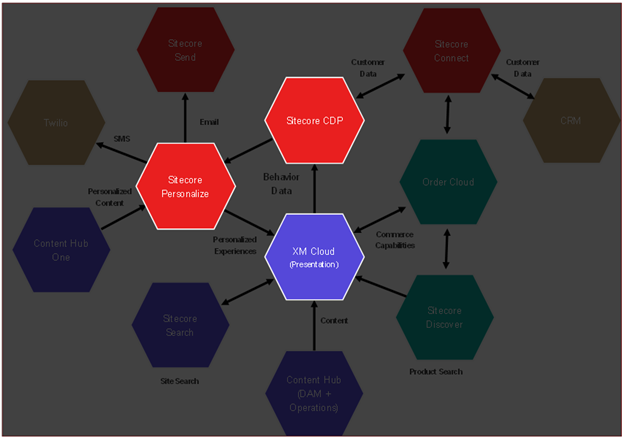In my last CMSWire Article, the Heart of Composable, I discussed how to think of composable as an enterprise architecture and think through the data flows of your components to see what’s at the heart of your DXP solution. Those central components have the most connections, take the most effort to change and require the most scrutiny to make sure your investments are aligned with your business goals.
It’s worth a full read, but I also demonstrated that content, customer data, and optimization capabilities are usually at the center of most organization’s DXP architecture and gave some guidance on what to think about when making those investments.
A lot of what I wrote was inspired heavily by Sitecore’s composable stack and wanted to show how the same principals I discussed in that article apply to customers leveraging Sitecore’s composable suite of products.
Three Clouds
Sitecore has divided its 11 SaaS products into three clouds: Content Cloud, Engagement Cloud, and Commerce Cloud. They are typically depicted using colored hexagons that look like this:

To really understand this architecture, you need to think about the data the flows between these systems, and the other systems each component will touch. Taking Sitecore’s product stack and thinking through common usage scenarios I came up with the following diagram to illustrate the vision for using all the products in your DXP.

Every organization may connect data a little differently, and I took some liberties to make this diagram cleaner (e.g., Combining DAM and Operations into one and using Content Hub One to drive Personalized Content), but this should give a good overview of how Sitecore’s composable architecture works when adopting all its components. It also can give you a good idea of what to think through when evaluating Sitecore’s tools against competitors as you will need to make sure they support similar data flows and usage patterns.

Looking at this diagram, you see that there are three components at the heart of the architecture: Content, Customer Data and Optimization capabilities.
In my CMSWire article, I make the case for their importance to your DXP solution. I think Sitecore’s offerings for each of these are robust and market leading in features and functionality.
XM Cloud, Sitecore Personalize, Sitecore CDP
XM Cloud is Sitecore’s flagship CMS. It’s SaaS based, meaning you don’t have to worry about infrastructure or upgrades. It supports for headless architecture enables you to leverage content without latency, driving lightning-fast performance. And they’re adding innovating solutions like edge-based personalization, reusable/embeddable components with front end as a service. Not to mention a next generation UX for site and content authoring.
Sitecore Personalize is truly a composable optimization platform. It’s not focused on just personalizing or improving web site experiences but is truly meant as an optimization platform for your entire digital experience platform. Yes, you can easily target websites regardless of CMS platform (Yes, it even works with Adobe, Acquia, Optimizely, WordPress, etc.), but you can also trigger API calls to send email messages or text message or even just expose APIs with personalized content to mobile apps or other DXP solutions. Plus, it’s Decision Model capabilities allow you to take a data driven approach to personalization, leveraging next best action strategies and machine learning to figure out what content will help your customers advance their customer journeys.
Sitecore CDP allows you to create 360-degree views of your customers and visitors. You can get data in and out of the platform painlessly using streaming, batch, or interactive API’s. You can segment and sync customer data across platforms. And its tight integration with Sitecore Personalize provides this data with low latency so your personalized experiences and experiments perform as fast as customer’s expectations demand them to be.
I believe that each of these products are great candidates to become the heart of your composable architecture.
If you need help creating a composable roadmap or implementing any of Sitecore’s composable stack, we’d love to help. Reach out to me on LinkedIn, Twitter or fill out our contact form.

